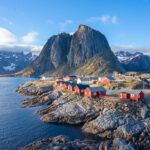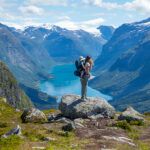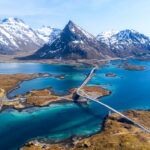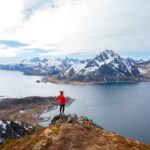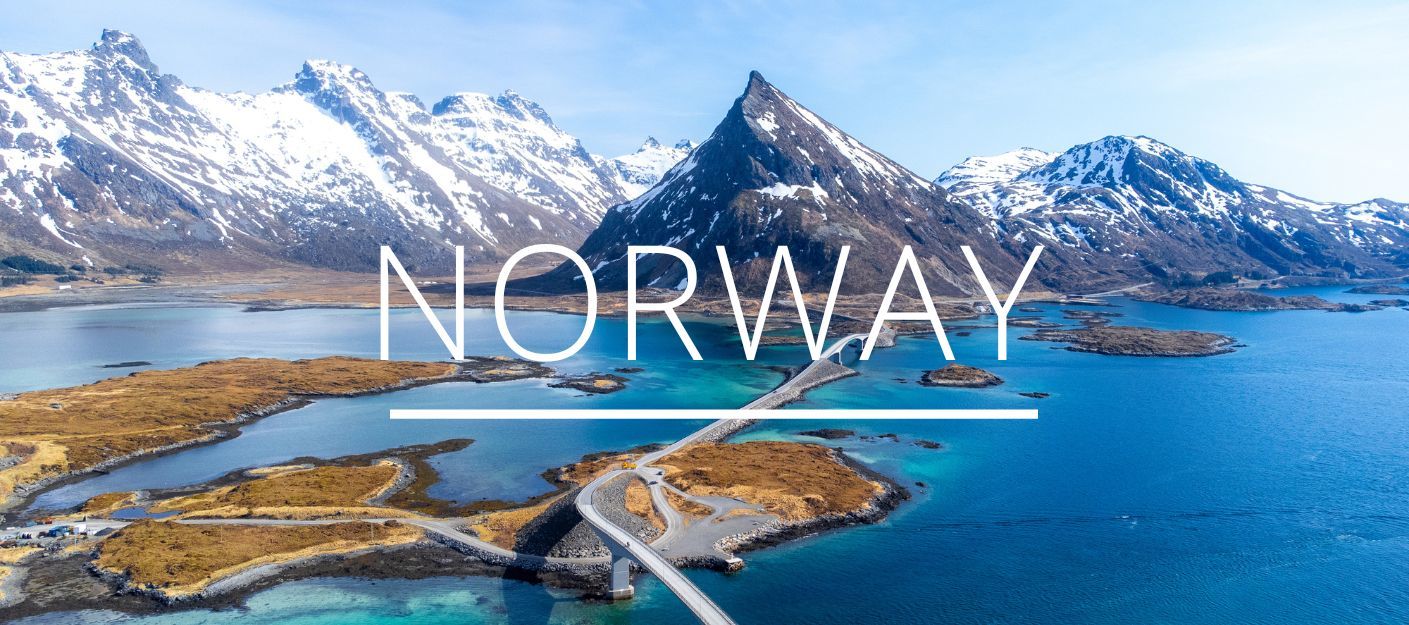
Covered in rugged landscapes, dramatic fjords, and towering mountains, Norway is a land of extremes. As you travel through this Nordic country, you'll be constantly amazed by the ever-changing scenery, from the majestic glaciers of the Arctic to the dense forests of the south. And just like its neighbors, waterfalls are everywhere, cascading down steep cliffs and creating a truly magical vibe.
While Norway has become a popular tourist destination, it's still possible to find secluded spots and unforgettable experiences. Whether you're a thrill-seeker dreaming of exploring the fjords, crave the peacefulness of a quiet fishing village, or hoping to see the Northern Lights, Norway has it all.
Where in Norway?

Norway
Quick Tips
- 'Hello' and 'Thank You' in Norwegian: “Hallo” (or "Hei") and “Takk”
- Currency: Norwegian krone (NOK)
- Visa: 90-day Schengen visa on arrival for most nationalities (click here for more info)
- Safety rating: Ranked 28 on the Global Peace Index with a score of 1.64 (USA is ranked 132 with a score of 2.62), making Norway one of the safest countries in the world.
- Climate: Norway's weather can be unpredictable, especially in coastal areas. It’s wise to pack layers and invest in good waterproof gear. Summer brings up to 24 hours of sunlight above the Arctic Circle, while winters are cold and magical, offering a chance to see the northern lights.
- Best SIM cards: Telenor or Telia – SIM cards are available at the airport, convenience stores, and supermarkets. IDs are required for purchase.
- Random useful tip: Norway is pretty quiet, which can be strange at first, but you'll get used to it! Try to keep your voice down and respect the peacefulness.
Accommodation
Low Budget Solo Travelers ($40 - $70): Hostels in Norway are a great option for budget-conscious travelers. While they might not be as common as in some other European countries, you can still find some affordable options., especially in major cities like Oslo, Bergen, and Tromsø. Booking in advance is highly recommended, especially during peak tourist seasons.
Mid budget solo travelers ($100 - $150): Expect to pay more than $100 for a private room with a private bathroom. Prices can vary depending on the location and amenities, but you should be able to find options within your budget. Keep in mind that hotels in Norway can be more expensive than in some other European countries, so it might be worth exploring alternative options.
Other Accommodation Options:
- Couchsurfing: Connect with locals and experience Norwegian hospitality by couchsurfing. This is a great way to meet people and learn about local culture.
- Camping: Norway offers amazing camping opportunities, with campgrounds located near fjords, mountains, and other natural attractions. This is a unique way to experience the country's beauty while saving some cash.
- Cabin Rentals: For a more cozy and secluded experience, consider renting a cabin. These can be found in various locations throughout Norway.
Food
Grocery Shop & Cook Your Own Food ($5 - $15): Food in Norway, much like the rest of Scandinavia, is not cheap. Eating out can easily cost upwards of $20 per meal, so one cost-saving option is to grocery shop and cook your own meals. In addition to saving money, this also allows you to experience local food culture by shopping at markets and preparing traditional dishes.
Norway is mainly known for its seafood, especially salmon, cod, and herring. You can find these fresh ingredients at local fish markets or supermarkets. For budget-friendly options, look for frozen seafood that you can thaw and cook yourself. Coop and Kiwi tend to be the most budget-friendly supermarkets in Norway.
Eating Out ($20 and up): Expect to pay at least $20 for a main at an average, inexpensive restaurant. If you want to save money but still experience eating out in Norway, stick with lunch specials or hit up the local food trucks, pop-up restaurants, or street food vendors.
Alcohol: Alcohol in Norway is heavily taxed and can be quite expensive. It's actually the second most expensive European country for alcohol after Iceland! A pack of Heineken will set you back just over $15.00.
Transportation
Getting Around: Traveling Norway is straightforward, with options like trains, boats, roads, and airports connecting the country's cities and scenic destinations. However, due to Norway's rugged terrain and long distances between towns, it may take longer than expected to reach certain places.
Inter-city Traveling: Getting from one Norwegian city to the next is best done by train. The railway system in Norway is well-developed and efficient, making it the most comfortable and convenient modes of transportation. The Norwegian State Railways (NSB) operates the majority of the country's trains, with a few private companies running smaller routes. Trains run frequently between major cities like Oslo, Bergen, Trondheim, and Stavanger, and also offer connections to smaller towns and villages throughout the country.
Things to Do
Get to Know Oslo: No trip to Norway is complete without a visit to the country's capital city. There is a ton to do in Oslo, and you'll need at least 2 days to experience the best of it. A few highlights you shouldn't miss include Vigeland Sculpture Park, the Viking Ship Museum, Oslo Opera House, and a stroll through the coolest neighborhood in town, Grünerløkka. Summer is peak tourism season, so visiting Oslo in the fall is ideal for travelers who are into a more low-key atmosphere.
The Norway in a Nutshell Tour: A must-do, especially for first-timers, is the Norway in a Nutshell tour. Starting in Bergen or Oslo, this tour takes you through some of Norway's most iconic landscapes, including a train ride on the most scenic railways and a ferry ride on Naeroyfjord, one of the narrowest fjords in Norway! If you're short on time, you can book a guided tour. These excursion are pricey, but you'll get a guide, and be able to see all of the highlights without having to worry about logistics.
You can also rent a car and put together your own Norway in a Nutshell tour. This is a great option if you are traveling with a group and want to save some money.
The Lofoten Islands: The Lofoten archipelago is a photographer's paradise, with its sharp peaks, white-sand beaches, and charming fishing villages. Spend a few days here hiking, kayaking, and exploring the idyllic towns like Reine and Å. If you’re lucky, you may catch a glimpse of the northern lights or enjoy the midnight sun. The islands are also famous for their world-class fishing, so be sure to try some local seafood.
Drive the Atlantic Road: The Atlantic Road is a popular thing to do in Norway, particularly because it has been called the world's most beautiful drive. This incredible drive hugs the coast between Trondheim and Ålesund, offering views of rocky islands and dramatic sea bridges along the way.
Explore the Fjords: One of the best ways to truly experience Norway is by venturing out into its natural landscapes to witness the majestic fjords with your own eyes. These deep, narrow waterways are carved into the country's coastline and boast insane views of towering cliffs, cascading waterfalls, and piercing blue waters.
See the Northern Lights: If you're traveling to Norway in winter, then seeing the northern lights is probably high on your bucket list. The further north you venture, the greater your chances of catching a glimpse of the Northern Lights. But even with careful planning and research, there's no guarantee of seeing this natural phenomenon. The highest probability for seeing the Northern Lights is planning your trip between November and March, making Norway one of the best places to visit in Europe in the winter.
